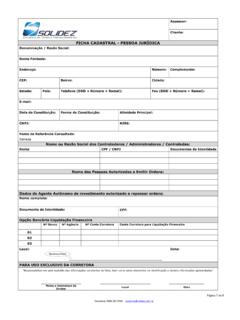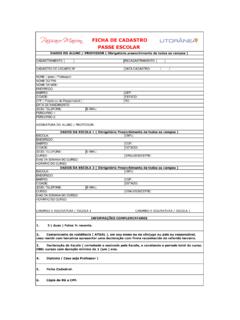Transcription of The Cadastral Template 2.0, From Design to Implementation
1 TS 7 Cadastre and Land Management Abbas Rajabifard, Daniel Steudler, Ali Aien, and Mohsen Kalantari The Cadastral Template , From Design to Implementation FIG Congress 2014 Engaging the Challenges, Enhancing the Relevance Kuala Lumpur, Malaysia, 16 21 June 2014 1/25 The Cadastral Template , From Design to Implementation Abbas RAJABIFARD (Australia), Daniel Steudler (Switzerland), Ali AIEN, and Mohsen KALANTARI, Australia Key words: Cadastral Template , Cadastral Template Project, Land Administration, PCGIAP SUMMARY In 2003, the Cadastral Template Project ( ) completed gathering data on four key issues under the support of the UN-sponsored PCGIAP Working Group 3 on Cadastre. These key issues are: the magnitude of the basic tasks in the Cadastral system; the magnitude and problems involved in the informal occupation of land; the role of the cadastre in SDI, and to get an appreciation of the completeness, comprehensiveness, use and usefulness of spatial Cadastral data; and lastly, to get an understanding of the capacity building activities in place or which are needed to be established to support the system.
2 The Cadastral Template Project has collected data on 47 different national Cadastral systems with updated reports being provided regularly by countries, demonstrating the continued merit of the exercise. However, in line with new technologies, the evolving conceptualisation of the role of the cadastre and an increasing focus on spatially enabled societies, an evolution of the project is now in the pipeline. This paper presents a new platform for the Template , Cadastral Template It will be a web-based resource that will gather and authenticate information through an enabling platform that is equipped with new functionalities and flexible Design for updating and populating information about cadastres. Cadastral Template will also be designed to reflect the increasing acknowledgement of the relationship between cadastres and the concept of spatially enabled societies.
3 Data of those 47 countries has been already moved into the Cadastral Template and it can be updated by the authorised users. TS 7 Cadastre and Land Management Abbas Rajabifard, Daniel Steudler, Ali Aien, and Mohsen Kalantari The Cadastral Template , From Design to Implementation FIG Congress 2014 Engaging the Challenges, Enhancing the Relevance Kuala Lumpur, Malaysia, 16 21 June 2014 2/25 The Cadastral Template , From Design to Implementation Abbas RAJABIFARD (Australia), Daniel Steudler (Switzerland), Ali AIEN, and Mohsen KALANTARI, Australia 1. INTRODUCTION Cadastres are regarded as the foundation for sustainable social, economic and environmental development of societies. In 2003, under the auspices of the UN-sponsored PCGIAP Working Group 3 on Cadastre, a generic Cadastral Template was developed to establish a standard form, which allowed Cadastral organisations to present and describe national Cadastral systems in a standardised format.
4 Such standardisation was important for enabling the identification of similarities and differences in matters such as land policy, laws and regulations, land tenure issues, institutional arrangements, spatial data infrastructures, technology, human resources and efforts to support capacity building. The Cadastral Template Project ( ) commenced and endeavoured to gather data on four key issues (Steudler et al., 2003; 2004): the magnitude of the basic tasks in the Cadastral system; the magnitude and problems involved in the informal occupation of land; the role of the cadastre in SDI, and to get an appreciation of the completeness, comprehensiveness, use and usefulness of spatial Cadastral data; and to get an understanding of the capacity building activities in place or which needed to be established to support the system.
5 A decade on, the Cadastral Template Project has collected data on 47 different national Cadastral systems with updated reports being provided regularly by countries, demonstrating the continued merit of the exercise (Country Report, 2003). However, in line with new technologies, the evolving conceptualisation of the role of the cadastre and an increasing focus on spatially enabled societies, an evolution of the project is now in the pipeline. This paper presents a new platform for the Template , Cadastral Template It will be a web-based resource that will gather and authenticate information through an enabling platform that is equipped with new functionalities and flexible Design for updating and populating information about cadastres. Cadastral Template will also be designed to reflect the increasing acknowledgement of the relationship between cadastres and the concept of spatially enabled societies (Rajabifard and Steudler, 2013).
6 In addition to continuing to collect Cadastral -related data, Cadastral Template will also seek to gather data on the key elements that have been identified for a spatially enabled society, as outlined in FIG Publication No. 58, Spatially Enabled Society : legal framework; common data integration concept; TS 7 Cadastre and Land Management Abbas Rajabifard, Daniel Steudler, Ali Aien, and Mohsen Kalantari The Cadastral Template , From Design to Implementation FIG Congress 2014 Engaging the Challenges, Enhancing the Relevance Kuala Lumpur, Malaysia, 16 21 June 2014 3/25 positioning infrastructure; spatial data infrastructure; land ownership information; and data and information. It is envisioned that this new platform of data will provide a fundamental resource to assist countries in assessing and benchmarking their own national systems.
7 This ultimately will facilitate the decision-making process in land administration systems and bring efficiency to their processes. 2. Web Web concepts encourage end users to interact and communicate with the web, rather than being a simple web reader. Web (websites, social media, etc) allows users to do more than just retrieve information. A user is invited to 'write' as well, instead of purely 'reading', or contribute to the content available to everyone in a user friendly way. By increasing Web features, the user has more user-interface, software and storage facilities, all through their browser (O'Reilly, 2005). Cadastral Template Project was designed successfully based on Web concept in 2003. However, existing of new technologies (technology push) and also the user demand to utilise these technologies led to develop Cadastral Template based on Web concepts.
8 3. Cadastral Template , Design Technologies used in the Cadastral Template The following web-based programming technologies have been used in this Template : Database o MySQL: to store and maintain Cadastral data provided by the individual participants. Back-end Technology o PHP: a server-side scripting language to communicate and retrieve the data from the database. Front-end Technology o JavaScript: client-side scripts to interact with the user and visualised the retrieved data. o JQuery: to simplify the client-side scripting of HTML. o Datamaps: a SVG-based data maps using to provide some data visualisations based on geographical data. o : a JavaScript library that uses digital data to drive the creation and control of dynamic and interactive graphical form.
9 TS 7 Cadastre and Land Management Abbas Rajabifard, Daniel Steudler, Ali Aien, and Mohsen Kalantari The Cadastral Template , From Design to Implementation FIG Congress 2014 Engaging the Challenges, Enhancing the Relevance Kuala Lumpur, Malaysia, 16 21 June 2014 4/25 o Google Chart API: A Google API to create charts from some data and embed it in a web page. Architecture of the Template Interactive Map and Visualisation features Architecture of Cadastral Template is based on providing interactive mapping services and visualisation features for end users. This helps users of the Template to analyse and compare different data and supports decision making for improving their Cadastral systems based on the findings from the Template . Figure 2 shows the designed interactive map of Cadastral Template Using this interactive map, users can perceive the distribution of countries which participated in this Template .
10 As it can be seen in figure 1, there is a gap in participation from North and South America, Africa, and Middle East regions. The ultimate goal of this architecture is to ease the data manipulation and updating process to encourage more participants. Open Source and free licensed technologies Also, all the deployed web technologies which are used in Cadastral Template are open source and they have free licensing systems. This provides more opportunities for other developers and increases engagement to improve this Template . Regional-based and country-based classes In Cadastral Template , countries are divided into 6 regions respectively Asia, Europe, Africa, North America, South America, and Oceania (Figure 1).







